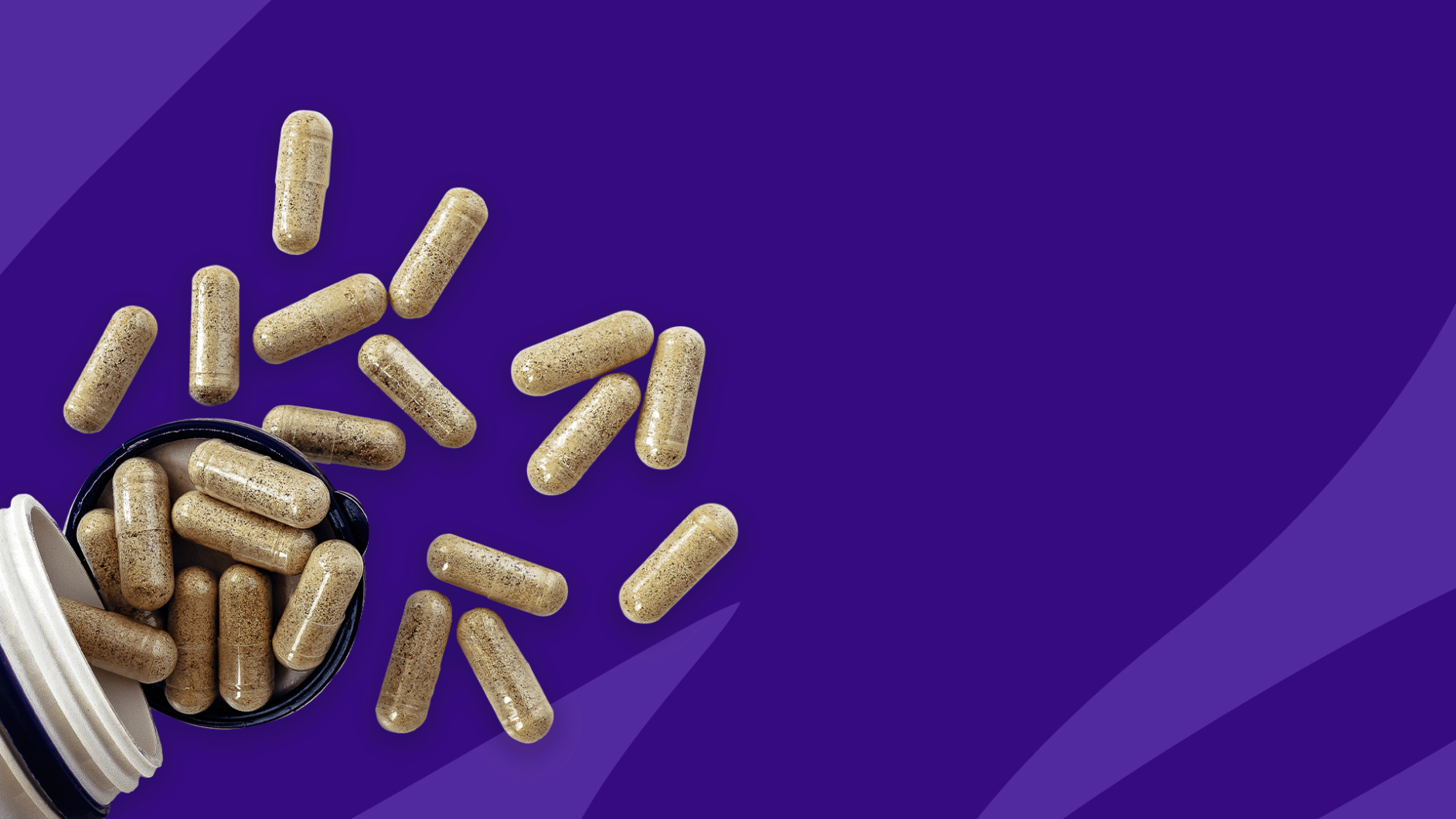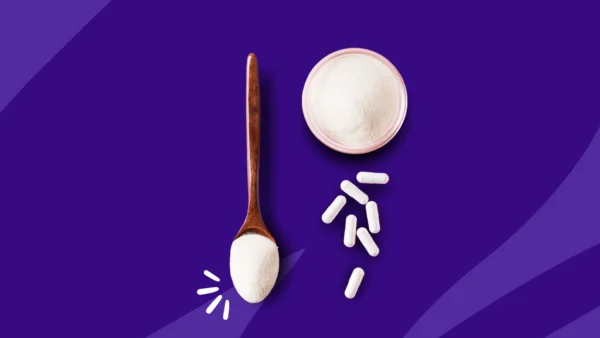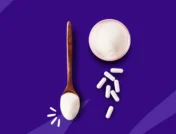Remember learning about chlorophyll in elementary school? Chlorophyll is the substance that gives many plants their green color. This green pigment is actually located inside oval-shaped bodies called chloroplasts, which are responsible for the process of photosynthesis. The chloroplasts take energy from sunlight and convert it into food for the plant.
Plants may not be the only living organisms to benefit from this phytochemical known as chlorophyll—people may be able to benefit from it, too. Chlorophyll is believed to have a number of potential health benefits, including support for the lungs. While you may have spotted influencers on social media guzzling chlorophyll water, that’s only one way to try it. You can enjoy eating plant-based foods that naturally contain chlorophyll, or you can take supplements. The supplements, which are available in both liquid and tablet form, usually contain a water-soluble form of chlorophyll called chlorophyllin.
Here’s what you need to know about the possible benefits of chlorophyll for lung health.
Chlorophyll benefits for lungs
The chlorophyll derivative chlorophyllin may have the ability to help fight lung cancer. According to a study published in 2016 in the journal Environmental Toxicology and Pharmacology, chlorophyllin showed some promise in targeting non-small cell lung cancer cells in mice. In fact, chlorophyllin seemed to have a protective effect that resulted in better and faster delivery of anti-cancer drugs to the cancer cells. Plus, it seemed to aid in the recovery of damaged tissues.
David Williams, PhD, principal investigator and cancer prevention professor at the Linus Pauling Institute at Oregon State University, explains that chlorophyllin can be a protective agent. According to the published study, chlorophyllin is water-soluble, unlike chlorophyll. This means that it’s able to bind to carcinogens or environmental mutagens in a way that regular chlorophyll can’t.
Dr. Williams notes that the research also suggests that chlorophyllin needs to be present along with the carcinogen in order to be really effective. “This makes sense if it’s physically binding to the chemical to prevent it from being absorbed,” Dr. Williams adds.
Similar research has been conducted with regard to liver cancer, suggesting that taking chlorophyllin supplements may help reduce the risk of liver cancer in people at high risk due to environmental factors, such as eating a diet high in foods contaminated with carcinogenic aflatoxins.
However, Dr. Williams also points out that most of the existing research on chlorophyll’s effect on lung cancer or lung health involves animals, which somewhat limits the ability to extrapolate the chlorophyll benefits for lungs to people.
Lindsey Wohlford, a registered dietitian at The University of Texas MD Anderson Cancer Center, urges caution when it comes to embracing chlorophyll as a way to improve respiratory health or prevent other conditions that may affect the lungs. “Currently, there is not adequate scientific evidence that chlorophyll provides benefits for lung health, lung cancer prevention, or any other health-related concern,” says Wohlford. “Much of the information available online is anecdotal, and studies in human subjects are minimal at best.”
Other health benefits of chlorophyll
Chlorophyll is reported to have some other health benefits beyond the lungs. Here are some common reasons people use chlorophyll:
- To fight acne: Some research has found that chlorophyll can help fight acne. One small, short-term study of about 10 people found that using a topical gel or ointment containing chlorophyllin helped clear up acne and minimized the appearance of large pores. Another small, randomized study examined the use of phototherapy with chlorophyll to treat acne and found that it was safe and effective with minimal side effects.
- To reduce inflammation: Various studies have shown that chlorophyll, chlorophyll derivatives, and chlorophyll-related compounds seem to have a positive effect in reducing inflammation and swelling. These anti-inflammatory properties could be useful in treating inflammatory conditions, such as arthritis.
- For its antioxidants: Chlorophyll is known for its antioxidant properties. In fact, a growing body of research, such as a study published in 2023 in the journal Molecules, supports this position, suggesting that it has a unique structure that makes it well-suited for targeting harmful free radical cells and reducing damage.
- For brain health: Eating greens may be good for keeping the brain healthy. Some research, including the aforementioned study published in Molecules, shows that chlorophyll has the potential ability to ward off oxidative stress and have a protective effect on brain cells, as well as reduce inflammation that might cause additional damage to brain cells.
- To heal wounds: For almost 100 years, some experts have extolled the virtue of chlorophyll in helping to heal wounds, as evidenced by a number of old studies in medical journals and textbooks. More recently, a literature review of more recent studies published in the journal Wound Management & Prevention found that chlorophyllin promoted wound healing. It’s even been shown to reduce pain when removing unhealthy tissue from wounds.
- To aid in weight loss: According to in vivo studies, foods and supplements containing chlorophyll might help suppress appetite and reduce weight gain.
- To treat anemia: A pilot study published in the International Journal of Chemical Studies suggests that chlorophyll’s chemical similarity to hemoglobin, which is a protein in red blood cells that carries oxygen, might be helpful in raising red blood cell levels. That might make it useful in treating iron deficiency disorders like anemia. Another study published in 2016 also found that chlorophyll may be helpful for people with anemia.
Myths about chlorophyll
There can be a tendency to exaggerate the health benefits of some supplements, which means that myths and misconceptions may crop up from time to time.
One common belief about chlorophyll is that it can get rid of bad smells. Although people once believed that it could help with reducing body odor, research doesn’t support the claim. A randomized, double-blind study from 1989 examined whether taking chlorophyll tablets three times per day could reduce the odor associated with a colostomy. However, when the researchers asked the 28 patients who participated in the study to give feedback, they did not report the chlorophyll supplements to be more effective than a placebo.
However, chlorophyllin being used to reduce bad smells is not completely a myth. It has been used to reduce the smells associated with urine and feces. In fact, a Wound Management & Prevention literature review suggests that it can be somewhat helpful in reducing unpleasant odors, such as those associated with wounds that are healing.
How to take chlorophyll supplements
There are various options for consuming chlorophyll, including chlorophyll-rich foods, liquid supplements, and tablets or capsules.
Foods
Green vegetables and fruits are an easy way for someone to increase their intake of chlorophyll. Try eating more dark green, leafy vegetables, such as spinach, kale, arugula, and romaine lettuce, as well as parsley, broccoli, green beans, green grapes, kiwi, and alfalfa. These types of chlorophyll-rich foods provide numerous other health benefits due to their fiber and vitamin content.
Liquid chlorophyll
Drinking chlorophyll—technically, it’s chlorophyllin—has been all the rage recently in certain corners of TikTok and other social media platforms. You can add a few drops of liquid chlorophyll or a scoop of powdered supplement to a glass of water and drink it. Currently, there’s no recommended daily allowance, but product labels may recommend drinking 100–200 milligrams daily, depending on the product.
Chlorophyll tablets, capsules, and gummies
If a traditional supplement is more appealing than a glass, there are plenty of options to choose from. Chlorophyll is also available in soft gel and gummy form, as well as in capsules and chewable tablets.
Chlorophyll side effects
Generally speaking, chlorophyll is considered to be safe and doesn’t create a lot of unpleasant side effects. In fact, the recent review of chlorophyll research published in Molecules stated, “Dietary supplements containing chlorophyll and chlorophyllin are available and generally considered safe, with no reported adverse side effects over several decades of human use.”
However, you may want to be cautious if you’re using a vitamin K antagonist blood thinner, such as Coumadin (warfarin), which is often used to reduce the risk of a heart attack or stroke. Leafy greens and chlorophyll supplements often contain a lot of vitamin K, and there is a possible risk of an interaction because warfarin actually interferes with the action of Vitamin K. Warfarin slows down the time it takes to produce a blood clot at a wound site, so consuming chlorophyll would work against the blood thinner.
Taking chlorophyllin supplements may also make you more sensitive to sunlight, which may be a concern if you’re taking any other medications that increase your sun sensitivity.
Making chlorophyll part of your diet
If you’re interested in possibly gaining some of the benefits of taking chlorophyll, you might start by incorporating more chlorophyll-rich foods into your diet. If you already enjoy eating arugula, try spinach or kale.
A few suggestions:
- Make a salad with spinach and arugula.
- Add a handful of spinach or kale leaves into a pot of soup.
- Saute spinach with olive oil and serve it with protein.
- Slice up a kiwi into a fruit salad.
- Steam some green beans and drizzle olive oil on top of them.
- Add some parsley to a pasta sauce.
It may be easier to just eat more chlorophyll-rich foods than to find a supplement that you know you can count on. In fact, that’s what Wohlford recommends.
“While many supplements offer some benefit, they simply are not a cure-all,” says Wohlford. “When asked about supplements for specific conditions or diseases, I usually remind people that if it were a miracle product, your doctor would be telling you to take it.”
Plus, the U.S. Food and Drug Administration does not regulate supplements like it regulates medications, so you can’t always be completely sure of what you’re getting when you purchase a supplement.
However, if you do choose to try a supplement containing chlorophyllin, read the label carefully and look for a third-party certification. Some third-party testing organizations or bodies that certify supplements include NSF International, U.S. Pharmacopeia, UL Solutions, and Consumer Lab. A seal on the package from one of these organizations is confirmation that the product actually contains the ingredients that it says it does.
Chlorophyll for lung health: Bottom line
Chlorophyll-rich foods and chlorophyll supplements may indeed provide some useful health benefits, although more research is needed to confirm that they’ll provide specific benefits for the lungs or respiratory system.
“In practical terms, chlorophyll has been used for many years in people for a variety of reasons,” notes Dr. Williams. Although the potential benefits outweigh the risks, Dr. Williams recommends whole food sources as a better alternative.
Wohlford emphasizes that it’s important not to rush out and purchase chlorophyll supplements—or any type of supplements—without checking with a healthcare professional who’s familiar with your medical history. “I recommend speaking to your doctor and your care team before starting any type of supplement as many of them can interfere with current medications and treatments,” Wohlford says.
Sources
- Nano-encapsulated chlorophyllin significantly delays progression of lung cancer both in in vitro and in vivo models through activation of mitochondrial signaling cascades and drug-DNA interaction, Environmental Toxicology and Pharmacology (2016)
- Chlorophyllin reduces aflatoxin indicators among people at high risk for liver cancer, Johns Hopkins Bloomberg School of Public Health (2001)
- Pilot study of topical copper chlorophyllin complex in subjects with facial acne and large pores, Journal of Drugs in Dermatology (2015)
- Photodynamic therapy using chlorophyll-a in the treatment of acne vulgaris: A randomized, single-blind, split-face study, Journal of the American Academy of Dermatology (2014)
- Phytol, a chlorophyll component, produces antihyperalgesic, anti-inflammatory, and antiarthritic effects: Possible NFκB pathway involvement and reduced levels of the proinflammatory cytokines TNF-α and IL-6, Journal of Natural Products (2020)
- Chlorophyll-related compounds inhibit cell adhesion and inflammation in human aortic cells, Journal of Medicinal Food (2013)
- Carotenoids and chlorophylls as antioxidants, Antioxidants (Basel) (2020)
- Enhancing health benefits through chlorophylls and chlorophyll-rich agro-food: A comprehensive review, Molecules (2023)
- Wound healing, The American Journal of Surgery (1945)
- Enzymatic debriding agents: An evaluation of the medical literature, Wound Management & Prevention (2008)
- A pilot study on wheat grass juice for its phytochemical, nutritional and therapeutic potential on chronic diseases, International Journal of Chemical Studies (2014)
- Effects of sodium ferrous chlorophyll treatment on anemia of hemodialysis patients and relevant biochemical parameters, Journal of Biological Regulators and Homeostatic Agents (2016)
- Chlorophyllin: Is it effective odor control? International Foundation for Gastrointestinal Disorders
- Can chlorophyll reduce fecal odor in colostomy patients? Ugeskrift for Laeger (1989)
- Blood thinners, MedlinePlus (2022)
- Warfarin interactions with food, Indiana Hemophilia & Thrombosis Center (2023)











